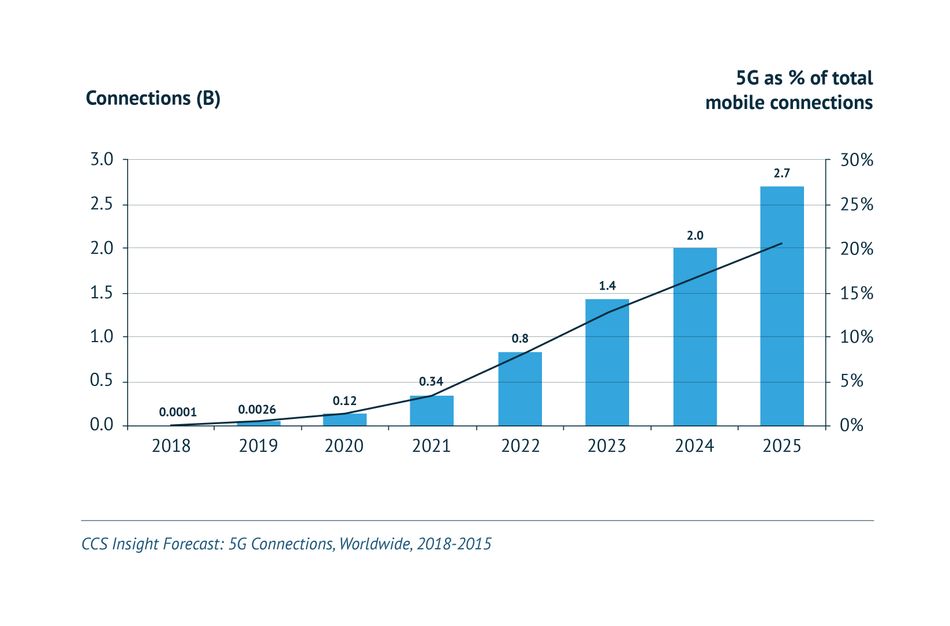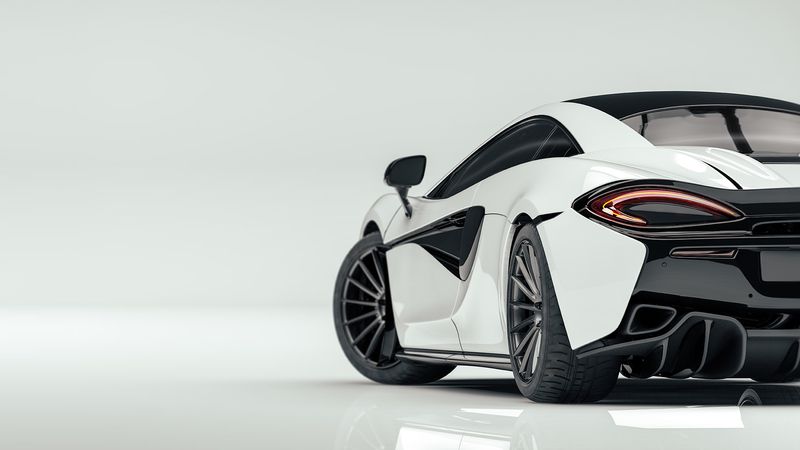5G Network brings Connected Cars closer
Article #1 of our Connected Transport Series. How The New 5G Mobile Standard Takes Connected Driving Another Step Closer to Reality.
This is the first article in a 5-part series exploring the connectivity solutions for the future of transportation. The series will detail various connectivity challenges engineers face and describe the technology that will provide the solutions to enhance transportation and driving experience.
The articles were originally published in an e-magazine, and have been substantially edited by Wevolver to update them and make them available on the Wevolver platform. This series is sponsored by Mouser Electronics, an online distributor of electronic components. Through their sponsorship, Mouser Electronics supports engineers in building a highly connected transport future in addition to knowledge sharing on related topics of electric vehicles, 5G, and autonomous transport.
Introduction
According to the 2019 Ericsson Mobility Report, by 2025, 2.6-billion 5G subscriptions will cover up to 65 percent of the world's population and transmit about 45 percent of the world's mobile data traffic. Forecasts also suggest Long-Term Evolution (LTE) will peak in 2022 at 5.4 billion subscriptions and will decline to 4.8 billion by the end of 2025 as LTE subscriptions migrate to 5G.
Those figures hint at 5G's market potential, especially considering that the study does not include the Internet of Things (IoT) or Connected Cars. Yet, they are a crucial target group for 5G devices – after all, the new standard pursues the goal of integrating machines and mobile communications for the first time.

5G is, therefore, not just an issue for the telecommunications sector but other branches of industry as well. For example, the automotive industry sees it as a means of achieving future visions, most notably the long-publicized - and safe - introduction of the Level 4 or 5-capable autonomous vehicle. That task will require overcoming several obstacles, including the continued development of 5G standards and implementing security features in the Connected Car and challenges such as integrating the technology into the vehicle and antenna alignment.
This article addresses these 5G implementation questions, deals with developing powerful 5G antennas, and discusses security standards in the Connected Car. Finally, it illustrates the possibilities that 5G offers a Connected Vehicle and the economy.
 Figure 2: Mobile subscriptions by technologies (in millions).
Figure 2: Mobile subscriptions by technologies (in millions).Current Status and Application Areas of 5G
The introduction of the new 5G mobile standard is currently being introduced. Initial requirements for the standard have been set while its detailed definition and subsequent implementation are now in the process of being launched. The successor to the current mobile standard LTE (4G) is intended to reduce latency, deliver higher bandwidth, and facilitate the creation of new possible applications thanks to its enhanced performance. There will be several development levels or releases.
Standardization of 5G started in 2016 and was formalized with Release 15 (R15), published by the 3rd Generation Partnership Project (3GPP) in June 2019. This publication determined the specifications for current 5G mobile devices, including CPEs and handsets. It also set two frequency ranges: Frequency Range 1 (FR1) with frequency bands previously below 6GHz and now (per R16) below 7.125GHz; and Frequency Range 2 (FR2), with frequency bands below 52.6GHz, including a part of the so-called mmWave spectrum.
Release 16 (R16) was delayed until June 2020 by COVID-19 and fixed 5G/NR-V2X. Future releases will address other topics, such as the integration of higher frequency bands up to 100GHz. Content for Release 17 (R17) is targeted for completion by March 2022, and R18 will address new topics with a completion target of late 2022/early 2023.
Huge Potential for 5G in Three Application Areas
The consumer sector, enhanced mobile broadband - eMBB, is the first area to benefit from the widespread development of 5G technologies. More significant traffic and lower network power consumption are expected to enable many devices simultaneously without network losses. This has the potential to improve user convenience and quality of experience (QoE), for example, boosting network capacity for large crowds - such as at concerts or sporting events - where many personal devices are used concurrently in concentrated numbers.
A second application area is massive machine-type communication (mMTC). This issue is becoming more relevant, especially when concerned with networking devices as part of the Internet of Things (IoT). The objective will be to enable communication of up to one million connected devices per square kilometer.
However, it is primarily the third potential application area that has aroused the automotive industry's interest in 5G: ultra-reliable low latency (URLL), ensuring reliable connections and short transmission times. ULL is vital to progressing self-driving vehicle technology.
5G holds the key to optimizing the integration of mobile communications into vehicles. As a result, several stakeholders are involved in defining 5G standards. Whereas the big players in the communications industry defined the existing standards, such as UMTS and LTE, new players who see the benefits 5G can bring are getting in on the act.
For this purpose, the automotive industry has established the 5G Automotive Association (5GAA), a body for defining 5G standardization requirements. A standard definition is vital so that efficient communication between devices from a host of different manufacturers is possible - for instance, in road traffic.
Omni-Directional Antennas and Signal Strength Challenges
Even though the automotive industry is very optimistic about the future of 5G, many details still have to be addressed to implement the technology. One challenge is integrating mobile communications and antenna technology, with the ultimate goal of creating a high-performance vehicle communication system.
With the need for more bandwidth, 5G will explore a wider operating frequency range from 6GHz to 100GHz. Currently, those signals are transmitted via cable connections from an antenna on a vehicle's roof to the onboard electronics, often located on the vehicle's floor or dashboard. Sending signals from the antenna to the electronics via cable would result in considerable losses.
That means the electronics, and thus signal processing must be positioned close to the antenna - such as within the roof or in the antenna itself, leading to potential packaging problems. Fluctuating weather conditions and temperatures can have a severe impact on the electronics' performance and operating lifecycle. Currently, relatively few manufacturers are able to develop concepts that combine multiple hidden antennas with electronics that can meet the demands of the automotive industry.
The frequency range from 6GHz to 100GHz increases radio field attenuation, which means signals are received from a shorter distance. That results in problems with omnidirectional antennas, which cannot then receive signals or can do so only to a limited extent. Although the reception can be increased through the pinpointed alignment of an antenna, devices must instead employ a larger number of antennas. As a result, there will always be antennas available regardless of the direction of the transmitter. Roadside units must also be equipped with directional antennas to transmit the signal to devices in passing cars. Some antenna manufacturers, including Molex, are already working together with carmakers to solve this problem.
The Future of 5G in the Connected Car
5G will progressively replace the current mobile LTE standard. Experts estimate millions of networked cars and trucks are already on roads worldwide and that the promised scenario of zero accidents will encourage this trend as we advance. In other words, 5G will help to realize the future vision of the Connected Car.
Until that can become a reality, carmakers are attaching great importance to installing all safety-and security-related sensors in the car itself. These sensors act autonomously, without any networking, and thus do not have to rely on wireless connections which may not yet function well enough.
Functions that operate using high-speed wireless connections will enhance convenience and, eventually, driver safety. For example, through the 5G network, a car will be informed of a traffic jam caused by an accident ahead and will then independently select an alternative route to avoid unnecessary delays.
However, all the vehicles on our roads will not become smart in one stroke, and our experience to date points to the future we might one day expect. The introduction of new mobile standards does mean that we can expect a new age in which mobile communications act more and more as an enabler for future visions as part of the IoT to dawn a little sooner.
5GAA
The 5GAA, which was established at the end of 2016, develops, tests, promotes communications solutions, supports their standardization, and accelerates the commercial availability of relevant products and solutions. Its goal is to address the desire for connected mobility and safety concepts with applications such as connected autonomous driving and complete access to services. As a 5GAA member, Molex supports technical working groups and GNSS development, and high-speed wireless technology to meet the future need for 5G technologies.
5G integration will make the Connected Car part of the IoT ecosystem. Cars will then communicate with each other - this is also possible using LTE-based modules - and other vehicles, such as bicycles, or even with infrastructures such as parking systems. This will increase road safety and pave the way for autonomous driving.
Security in the Connected Car
Security testing will be of particular importance in the battle against cybercrime. In particular, penetration tests reveal security gaps, where a tester deliberately tries to penetrate the system with the means and methods used by hackers. The results ascertain the current security strength, which engineers then use as the basis for countermeasures to eliminate critical weaknesses.
Organization and development processes also need to be adapted to new circumstances. For example, end-to-end risk analyses have not traditionally been the rule but should be one of the absolute requirements manufacturers ask of their suppliers. Such a study investigates potential attacks on all the chain components, their effects on data security, and, ultimately, functional safety. Engineers can use the results to define suitable protective measures. The procedure's success depends upon the cooperation, from early-stage development, of the OEM, the back-end solution supplier, and the control unit manufacturers.
Road Safety Enabler
5G not only offers new commercial possibilities for the automotive industry. The new mobile standard and the innovations it produces will also improve road safety. With 5G, road operators could conceivably use connected vehicle data to ensure traffic flows and avoid crowded environments that could lead to accidents. Additionally, crucial alerts such as left-turn assistance will support the driver in challenging situations. The new 5G-based infrastructure will create a less stressful driving experience. For example, traffic-light-optimized speed-advisory systems will regulate traffic from intersection to intersection. Likewise, self-driving vehicles could use privileged lanes and thus enable convenient driving and mobility. With 5G, the ambitious vision of zero-accident vehicles seems to be within reach.
5G Vehicle Communication Systems Manufacturer
Molex is a global leader in radio frequency (RF) technology - development and production to life-long system support. Molex is currently the only Tier-1 vendor that can unite expertise in wireless and wired vehicle communication solutions, offering the automotive industry a complete end-to-end system, from the cloud to the sensors and back. Enhanced mobile broadband is crucial for Molex: 5G will use FR2, the extended mmWaves frequency bands, which are ten times broader than the LTE band. This is vital to the development of Telematics Antenna Fusion systems, which Molex is steadily driving forward.
This article was originally published by Mouser and Molex in an e-magazine and substantially edited by the Wevolver team. It's the first article of a 5-part series exploring connectivity solutions for the future of transportation.
The second article discussed connected transport and automotive ethernet.
The third article introduces the modularity challenges of Connected Cars.
The fourth article stressed the importance of regulations and infrastructure changes in order for connected cars to realize their potential.
The fifth article looked at connectivity requirements for ADAS.
About the sponsor
Mouser Electronics is a worldwide leading authorized distributor of semiconductors and electronic components for over 1,100 manufacturer brands. They specialize in the rapid introduction of new products and technologies for design engineers and buyers. Their extensive product offering includes semiconductors, interconnects, passives, and electromechanical components.
Sources and further reading:
Ericsson Mobility Report 2019 https://www.ericsson.com/4acd7e/assets/local/mobility-report/documents/2019/emr-november-2019.pdf
5G Standardization : https://www.ericsson.com/en/future-technologies/standardization/5g-standardization
3GPP Release 17 timeline confirmed: https://www.3gpp.org/news-events/2145-rel-17_newtimeline


